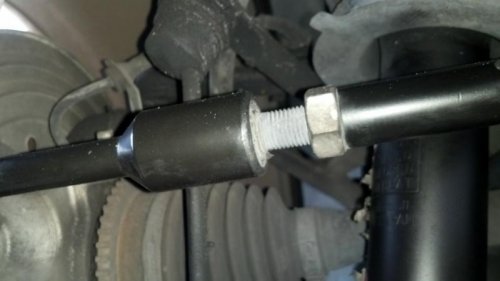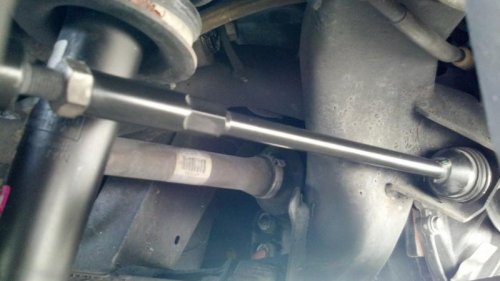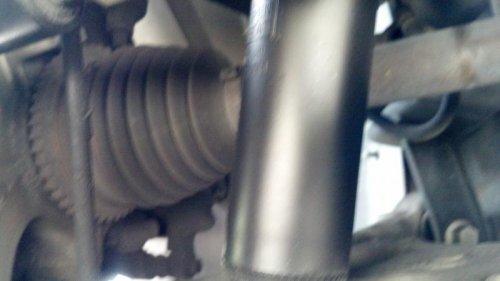theophile
Well-Known LVC Member
I have my rear lower control arms out of the car, and I have used an Autozone loaner ball joint press set to press out the two ball-joint-style bushings. I intend to replace them with the Jaguar bushings from Racing Green. Here are some side-by-side pics of the old and new bushings:
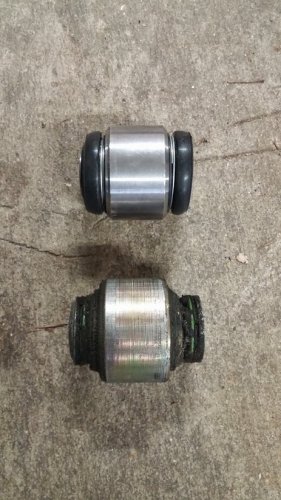
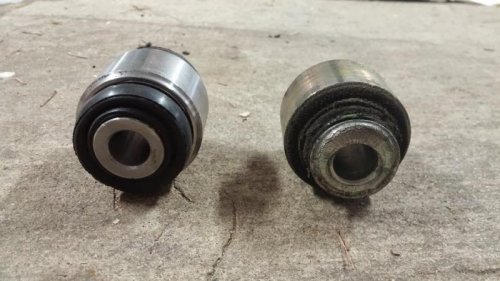
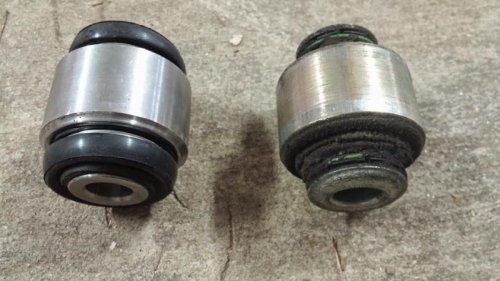
I have been operating under the assumption that the correct way to press in the new bushing is to use a driver that will fit over the rubber "boot" and mate against the rim of the outer sleeve, while being just narrow enough that it will fit into the control arm. In other words, I've been assuming that I do not want to press in the new bushing by applying the force to the inner sleeve.
So far, I have not been able to find a suitable "tube" to use for pressing in the new bushings in the manner described above. But because I am not as concerned about damaging the old bushings, I went ahead and pressed them out using the Autozone tool by applying the force to the inner sleeve. This is the ball joint press I'm using (though this is not my picture):
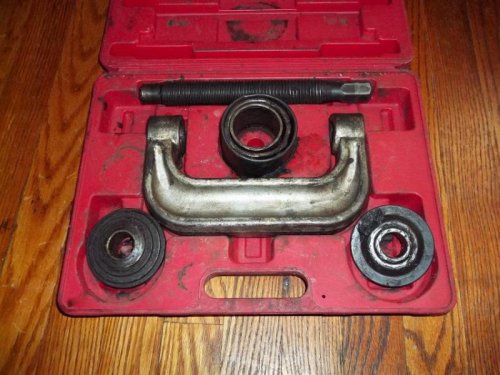
For the first one, I used one of the plates in the kit that has a somewhat rounded bottom. As you can see in the pictures above, this rounded off the end of the inner sleeve on the first bushing I pressed out. For the second one I just put the flat part of the driver screw against the inner sleeve of the bushing and it worked fine and did not deform the inner sleeve as happened with the first one.
For both bushings I pressed out, I had to load a pretty substantial amount of force into the press before the bushing broke free from whatever bond was keeping them in the control arms. In both cases, when that bond broke, it was a loud cracking sound, after which it was comparatively easier to continue pressing the bushing out. The first time this happened I was scared I had cracked the aluminum control arm, but thankfully that was not the case.
So now I am wondering the best way to get the new bushings in. As mentioned above, I had been assuming I did not want to press on the inner sleeve of the new bushing and risk damaging it. But the old bushings (which are obviously very badly worn) do not seem to have suffered any deformity or other damage as a result of all that force having been applied to the inner sleeve. This is emboldening me to try to press the new bushings in in the same manner I pressed the old ones out, but I wanted to bounce it off the group before I give it a try.
My second question is whether I should put some type of lubricant on the outer sleeves before pressing them in. It seems like this could make the process a little smoother and require a little less force to press the new ones in, which in turn could reduce the risk of damage to the new bushings. On the other hand, it did seem as though there was something bonding the old bushings to the control arms. I supposed it could have just been the result of 12+ years of slight expansion and contraction of the metal, but I wanted to make sure I'm not supposed to use some sort of loctite-like adhesive substance.
I'd appreciate any thoughts you might have about this project. Thanks!







I have been operating under the assumption that the correct way to press in the new bushing is to use a driver that will fit over the rubber "boot" and mate against the rim of the outer sleeve, while being just narrow enough that it will fit into the control arm. In other words, I've been assuming that I do not want to press in the new bushing by applying the force to the inner sleeve.
So far, I have not been able to find a suitable "tube" to use for pressing in the new bushings in the manner described above. But because I am not as concerned about damaging the old bushings, I went ahead and pressed them out using the Autozone tool by applying the force to the inner sleeve. This is the ball joint press I'm using (though this is not my picture):

For the first one, I used one of the plates in the kit that has a somewhat rounded bottom. As you can see in the pictures above, this rounded off the end of the inner sleeve on the first bushing I pressed out. For the second one I just put the flat part of the driver screw against the inner sleeve of the bushing and it worked fine and did not deform the inner sleeve as happened with the first one.
For both bushings I pressed out, I had to load a pretty substantial amount of force into the press before the bushing broke free from whatever bond was keeping them in the control arms. In both cases, when that bond broke, it was a loud cracking sound, after which it was comparatively easier to continue pressing the bushing out. The first time this happened I was scared I had cracked the aluminum control arm, but thankfully that was not the case.
So now I am wondering the best way to get the new bushings in. As mentioned above, I had been assuming I did not want to press on the inner sleeve of the new bushing and risk damaging it. But the old bushings (which are obviously very badly worn) do not seem to have suffered any deformity or other damage as a result of all that force having been applied to the inner sleeve. This is emboldening me to try to press the new bushings in in the same manner I pressed the old ones out, but I wanted to bounce it off the group before I give it a try.
My second question is whether I should put some type of lubricant on the outer sleeves before pressing them in. It seems like this could make the process a little smoother and require a little less force to press the new ones in, which in turn could reduce the risk of damage to the new bushings. On the other hand, it did seem as though there was something bonding the old bushings to the control arms. I supposed it could have just been the result of 12+ years of slight expansion and contraction of the metal, but I wanted to make sure I'm not supposed to use some sort of loctite-like adhesive substance.
I'd appreciate any thoughts you might have about this project. Thanks!

